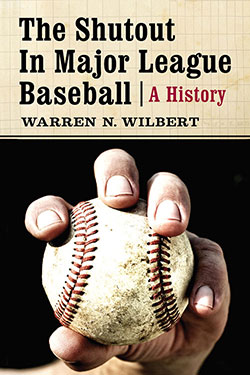A shutout in baseball occurs when one team prevents the other from scoring any runs during a game. This feat highlight exceptional pitching and defense.
Baseball fans love the excitement and strategy of the game. One of the most impressive displays of skill is the shutout. It requires a pitcher to dominate the opposing team, often with the help of strong defense. Achieving a shutout showcases the team’s ability to maintain focus and control throughout the game.
Understanding what makes a shutout special can deepen your appreciation for baseball. Let’s explore how shutouts happen and why they are so important in the sport.
Introduction To Shutouts
In baseball, shutouts are thrilling moments. They showcase the skill and determination of a pitcher. Fans love the drama and tension.
Understanding what a shutout is can deepen your appreciation for the game. It’s a significant achievement, both historically and in the present day.
Definition Of A Shutout
A shutout occurs when a single pitcher prevents the opposing team from scoring. This must happen over the entire game. The pitcher must pitch all nine innings without allowing a run.
If a pitcher achieves this, it’s called a “complete game shutout.” It’s a rare feat and a sign of great skill.
Historical Significance
Shutouts have a rich history in baseball. They highlight the game’s evolution and the legends who have played it. Early baseball had many more shutouts. Pitchers dominated the game.
As the game evolved, shutouts became rarer. This makes them even more special today. Great pitchers are remembered for their shutouts. They are milestones in their careers.
Here are some notable pitchers with many shutouts:
| Pitcher | Shutouts |
|---|---|
| Walter Johnson | 110 |
| Grover Cleveland Alexander | 90 |
| Christy Mathewson | 79 |
These names are legendary. Their shutouts are part of baseball lore.
How Shutouts Work
Understanding how shutouts work in baseball can enhance your appreciation of the game. A shutout occurs when one team prevents the other from scoring any runs throughout the entire game. It’s a remarkable feat that showcases excellent pitching and stellar defense. Let’s dive deeper into how shutouts work by exploring the pitcher’s role and defensive strategies.
Pitcher’s Role
The pitcher is the key player in a shutout. They must throw precise and effective pitches. This keeps opposing batters from reaching base. A pitcher needs control, power, and a variety of pitches. This mix keeps batters guessing. Consistency is crucial. A single mistake can cost the shutout. The pitcher must stay focused for the entire game. Pitching a shutout is physically and mentally demanding.
Defensive Strategies
While the pitcher is vital, the defense also plays a critical role. Fielders must be sharp and alert. They need to make quick and accurate throws. Positioning is essential. Fielders need to anticipate where the ball will go. Communication among players is key. They must work together to prevent runs. Outfielders catch fly balls, while infielders stop ground balls. Every player’s effort contributes to maintaining the shutout.
Famous Shutout Games
Shutout games are rare and exciting events in baseball. These games show the skill of pitchers and the defense of teams. Some shutout games have become famous over the years. Let’s take a look at some of these memorable matches.
Iconic Matches
Some shutout games stand out in baseball history. These matches often feature incredible performances by pitchers.
- Don Larsen’s Perfect Game: In the 1956 World Series, Larsen pitched a perfect game for the New York Yankees. This is the only perfect game in World Series history.
- Madison Bumgarner’s 2014 World Series Performance: Bumgarner pitched a complete game shutout in Game 5, leading the San Francisco Giants to victory. His performance is still talked about today.
Record-breaking Performances
Some shutout games break records and set new standards. These performances are celebrated by fans and remembered for years.
| Pitcher | Team | Year | Details |
|---|---|---|---|
| Walter Johnson | Washington Senators | 1913 | Johnson pitched 11 shutouts in one season, a record that still stands. |
| Nolan Ryan | Texas Rangers | 1990 | Ryan pitched a no-hitter, with 14 strikeouts, at age 43. |

Credit: en.wikipedia.org
Pitching Techniques
In baseball, a shutout is a remarkable achievement for a pitcher, where no opposing player scores a run. Mastering various pitching techniques is key to achieving a shutout. These techniques involve selecting the right pitches and maintaining the pitcher’s stamina throughout the game.
Effective Pitches
To keep the opposing team from scoring, pitchers use a mix of effective pitches. Here are some common ones:
- Fastball: The most basic pitch. It is thrown at high speed to catch the batter off guard.
- Curveball: This pitch has a sharp, curving motion. It can deceive batters.
- Slider: A pitch that breaks laterally and down. It is harder to hit cleanly.
- Changeup: Thrown to look like a fastball but at a slower speed. It disrupts the batter’s timing.
Maintaining Stamina
Maintaining stamina is crucial for a pitcher aiming for a shutout. A pitcher must manage their energy effectively. Here are some tips:
- Consistent Training: Regular exercise strengthens the pitcher’s arm and body.
- Proper Diet: Eating balanced meals ensures the pitcher has the energy needed for the game.
- Rest: Adequate sleep helps in recovery and performance.
- Hydration: Drinking enough water keeps the pitcher focused and prevents fatigue.
By using these pitching techniques, a pitcher increases their chances of throwing a shutout. Combining effective pitches with good stamina management can lead to success on the mound.
Defensive Support
In baseball, achieving a shutout is no small feat. It requires a team effort, especially strong defensive support. This means more than just a great pitcher. The entire defense needs to be on point.
Fielding Excellence
Fielding excellence is crucial for a shutout. Fielders must be alert and ready. They need to make accurate throws and quick decisions. Every position matters, from the first baseman to the outfielders. A single error can ruin a shutout. So, flawless fielding is key.
Catcher’s Contribution
The catcher plays a vital role in a shutout. They guide the pitcher with pitch selection. They must be good at framing pitches. This means making borderline pitches look like strikes. They also need to stop wild pitches and prevent stolen bases.
Communication is another key aspect. The catcher must communicate with the pitcher and fielders. They call out plays and strategies. This keeps everyone on the same page. A good catcher can make a huge difference in achieving a shutout.

Credit: apnews.com
Impact On Team Success
A shutout in baseball is a remarkable achievement. It doesn’t just reflect the skill of the pitcher. It also has a significant impact on the entire team. The success of a team is often influenced by these standout performances.
Boosting Morale
A shutout can greatly boost team morale. When a pitcher throws a shutout, it sends a strong message to the team. It shows that hard work and strategy pay off. This can inspire other players to perform better.
Here are a few ways a shutout can lift team spirit:
- Increases confidence in the team’s pitching staff.
- Encourages better performance from other players.
- Builds a sense of unity and teamwork.
Season Implications
Shutouts can have major implications for a team’s season. They can turn the tide in close races for playoff spots. Consistent shutouts can improve a team’s standing in the league.
Consider these points:
- Improves the team’s win-loss record.
- Provides a psychological edge over opponents.
- Helps in securing critical wins during the season.
Below is a table showing the impact of shutouts on team performance:
| Team | Shutouts | Win-Loss Record |
|---|---|---|
| Team A | 10 | 85-77 |
| Team B | 15 | 90-72 |
| Team C | 5 | 80-82 |
As the table shows, teams with more shutouts often have better records. This highlights the importance of shutouts in achieving team success over a season.
Comparing Shutouts To No-hitters
Baseball fans often talk about shutouts and no-hitters. These terms describe different pitching achievements. Both involve a pitcher dominating a game. But they are not the same. Let’s explore the key differences and similarities between a shutout and a no-hitter.
Key Differences
A shutout occurs when a pitcher prevents the opposing team from scoring any runs. The pitcher must play the entire game. It doesn’t matter how many hits the opposing team gets. The focus is on the runs, not the hits.
A no-hitter is different. In a no-hitter, the pitcher doesn’t allow any hits. The opposing team may get on base through walks, errors, or hit-by-pitches. But they must not get any hits. The pitcher must also play the entire game.
| Shutout | No-Hitter |
|---|---|
| No runs allowed | No hits allowed |
| Focus on runs | Focus on hits |
| Team can have hits | Team can score runs |
Similarities
Both achievements require the pitcher to stay in the game. The pitcher must maintain control and focus. Both show great skill and endurance.
- Pitcher must play the full game.
- Showcases pitching skill.
- Demands strong defense.
Both are rare and celebrated events in baseball. Fans love to see these performances. They highlight the best in pitching talent. Whether a shutout or a no-hitter, both are amazing feats.
Memorable Shutout Moments
A shutout in baseball is a game where one team prevents the other from scoring any runs. These games are rare and thrilling for fans. Let’s dive into some of the most memorable shutout moments in baseball history.
Player Highlights
Many players have delivered unforgettable shutout performances. Here are a few highlights:
- Sandy Koufax: Sandy Koufax pitched a perfect game on September 9, 1965. He struck out 14 batters and allowed no hits.
- Nolan Ryan: Nolan Ryan threw seven no-hitters in his career. His last no-hitter was a 1991 shutout against the Toronto Blue Jays.
- Don Larsen: Don Larsen pitched a perfect game in the 1956 World Series. It remains the only perfect game in World Series history.
Unforgettable Plays
Shutout games often feature extraordinary plays. Here are some unforgettable moments:
- The Catch by Willie Mays: In 1954, Willie Mays made a legendary over-the-shoulder catch. This play helped preserve a shutout in Game 1 of the World Series.
- Mark Buehrle’s Perfect Game: On July 23, 2009, Mark Buehrle pitched a perfect game. Dewayne Wise’s incredible catch in the ninth inning saved the perfect game.
- Roy Halladay’s Playoff No-Hitter: Roy Halladay threw a no-hitter in the 2010 playoffs. It was only the second no-hitter in MLB postseason history.
Challenges Of Achieving A Shutout
Achieving a shutout in baseball requires exceptional skill and concentration. Pitchers must prevent the opposing team from scoring any runs. This challenge demands flawless teamwork and strategy.
Achieving a shutout in baseball is a remarkable feat. It requires a pitcher to prevent the opposing team from scoring throughout the entire game. This is a rare accomplishment due to the numerous challenges involved. From physical endurance to mental fortitude, maintaining a shutout is no easy task.
Physical Demands
Pitching a complete game without allowing a run is physically taxing. A pitcher must maintain peak performance for nine innings. Fatigue sets in as the game progresses. The arm, shoulder, and body endure immense strain. Consistent velocity and control are essential. Each pitch must be precise. Any mistake can lead to runs. Proper conditioning and stamina are vital. Recovery between games is crucial. Pitchers often need several days of rest.
Mental Toughness
Mental strength is equally important. Pitchers must stay focused and confident. One mistake can change the game. Handling pressure is crucial. The crowd, opposing team, and game situation create stress. Staying calm and composed is necessary. Distractions must be ignored. Mindfulness techniques help maintain focus. Mental preparation is key. Visualization and positive thinking can boost performance. A strong mindset can make the difference.

Credit: mcfarlandbooks.com
Shutouts In Modern Baseball
Shutouts in Modern Baseball are a rare and exciting feat. A shutout occurs when a team prevents the opposing team from scoring any runs in a game. This shows the pitcher’s skill, the defense’s strength, and strategic management. In modern baseball, shutouts are less common due to various factors.
Current Trends
In today’s game, shutouts are not as frequent. Several factors contribute to this trend:
- Increased focus on pitch counts
- More specialized relief pitching
- Higher offensive strategies
Pitchers are often taken out of the game earlier to prevent injury. Relief pitchers then take over, making it harder for a single pitcher to achieve a shutout. Teams also focus more on offensive tactics, which increases the likelihood of runs being scored.
Future Predictions
The future of shutouts in baseball might see even fewer occurrences. Here are some potential changes:
- Advanced player analytics
- Increased use of bullpen
- New training methods
With advanced analytics, teams can better understand pitcher fatigue and opposing team strengths. This leads to more precise management of pitching rotations. The use of bullpens will likely increase, with teams relying on multiple pitchers per game. Training methods will continue to evolve, focusing on both preventing injuries and maximizing performance.
Overall, the shutout will remain a special achievement. But its frequency will probably decline due to these modern strategies.
Frequently Asked Questions
What Is A Shutout In Baseball?
A shutout in baseball is when a team prevents the opposing team from scoring any runs throughout the entire game.
How Common Are Shutouts In Baseball?
Shutouts are relatively rare in baseball. They showcase a dominant performance by the pitcher and the defensive team.
Can A Team Score During A Shutout?
No, during a shutout, the opposing team is unable to score any runs throughout the game.
Who Gets Credit For A Shutout?
The pitcher who pitches the entire game without allowing any runs gets credit for a shutout.
Conclusion
A shutout in baseball is a thrilling achievement. It showcases a pitcher’s skill. Fans love the excitement and tension. Teams celebrate this rare feat with pride. Understanding shutouts enhances your appreciation of the game. Next time you watch baseball, notice the pitchers’ efforts.
Their hard work makes shutouts possible. Enjoy the game and the moments that make it special. Baseball’s unique elements, like shutouts, keep fans coming back. Stay curious and keep learning about this sport.





